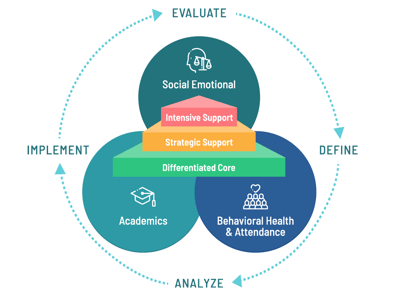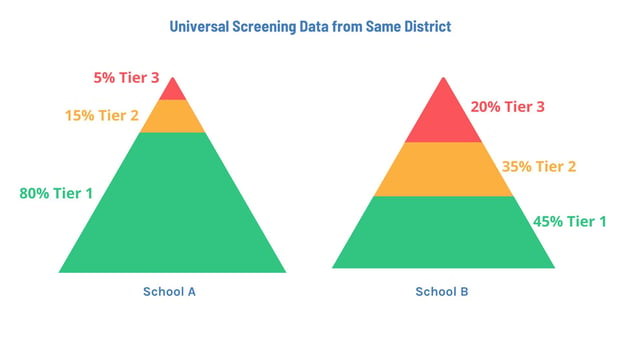
How MTSS Utilizes Universal Screeners to Tier Equitably
Years of data and research reveal inequities within education that continue to persist. With the best intentions, there are always ways in which the best system fails at meeting all needs. However, what separates educators and schools is what we do to correct the course or rebuild with equity.
Like when we go to the doctor for a checkup, screening questions and assessments check if there might be any signs of a problem. We should be doing the same with our schools.

One of the ways is using a Multi-Tiered System of Supports (MTSS) to support all students with the resources they need to overcome barriers to success. The Center for MTSS says, “MTSS has the potential to address these long-standing issues and build a new path forward given the flexibility inherent in the framework.”
The right kind of universal screener and equitable tiered support process benefits all students. Let’s look at how a quality universal screener and reflective practice prioritizes equity within the tiers of your MTSS framework.
What Is Universal Screening?
Universal screening is a process of assessing all students to identify individuals at risk or needing more individualized support. Screeners typically are those nationally or state-normed assessments given two/three times a year. These screeners gather initial data and information about the students, just as taking our blood pressure or lab tests can help identify a problem before one appears.
Implementing the MTSS framework requires using a universal screener to gather data and information about students multiple times a year. Whether a seasoned MTSS veteran or new to the practice, universal screening is key to understanding the starting point for students and determining a road map for growth.
There are two priorities with universal screening. The first is to determine if core instruction is sufficient, and the second is to identify those that need support. Not only does it matter what kind of assessment, but also how that assessment affects the decision-making.
A solid universal screener sets up the team on an excellent equity practice. Without a suitable screener, the decision process requires more time and leaves room for error. Dr. Eva Dundas, Chiefs Product Officer at Branching Minds, recommends the following qualities to consider:
A quality universal screener has:
- Validity - Accurately measures skills and abilities
- Reliability - Consistently measures skills and abilities
- Sensitivity - Accurately predicts if a student will fall behind
- Specificity - Accurately predicts students who won’t
- Practicality - Short and easy to give
- Consequential Validity - Not biased to a particular group
For more information about a quality universal screener, check out this webinar. As well, the website Intensiveintervention.org helps examine the screening tools used within your district.
How Are Universal Screeners Utilized in MTSS?
After choosing and implementing an equitable universal screener, the data gathered will provide an authentic look at the student as a whole child and pre-emptively spot those at risk. When it comes to providing different levels of support for students within the tiers of the MTSS framework, we want to ensure that we are using the data as it is intended; as an evaluation of core instruction and as an initial point of data to identify students at risk.
Universal Screeners are Utilized to Evaluate Core instruction
Examining the results begins by utilizing pre-existing criteria for performance expectations. Universal screeners have predetermined or suggested cut scores, which is an excellent place to start your MTSS process. The cut score should remain the same across all schools using this screener, and ideal data should indicate at least 80% of students successfully supported by Tier 1 Core Instruction, 5-15% of students needing Tier 2 support, and 1-5% of students requiring more intensive Tier 3 supports.
It's important to note that while Tier 1 core instruction should successfully support at least 80% of students, it should be accessible to 100% of students. (Learn more in this video.)
These scores will help reveal whether core instruction is sufficient. Solid core instruction contains differentiated, engaging, and evidence-based instructional strategies, and it should be a solid foundation to build upon within the other tiers. If Tier 1 core instruction is not successfully supporting at least 80% of students to meet grade level benchmarks, the school team should examine the core instruction for quality and delivery.
A universal screener is an evaluative tool measuring how well your core instruction works. The data received should be where content or grade-level teams can begin the data-informed decisions around the core instruction.
Universal Screeners are Utilized to Identify Students At Risk
The cut scores will help determine the students who need Tier 2 and 3 support. For example, from a reading screener, the universal screener will provide lists of students that fall between those cut scores. If the universal screener doesn’t offer a breakdown of skills, the next step would be to utilize a diagnostic assessment to determine what kind of support the student needs and create SMART goals for that specific student.
No screener is perfect and is a fix for all the work that goes into providing support for students at different levels. Choosing a robust universal screener avoids missing students or trying to “triangulate” or screen more than necessary. This flowchart will help MTSS teams make plans and goals for specific tier support. If data reveal a student in need of support, the MTSS team is tasked with deciding on goals and support a student needs.
Why Does the Universal Screener Matter for Equity?
Data matters significantly in all the research and information about equity within schools. The numbers don’t lie. According to the Learning Policy Institute, “A study of…policies found that, 7 years after school finance changes, the highest-poverty districts in the reform states experienced an average 12% increase in per-pupil spending and a 7 to 12 percentage point increase in graduation rates.” (Darling-Hammond, 2019)
Within the practice of implementing MTSS, there are several ways in which the universal screener reveals these inequities. These data points will go a long way in examining if your MTSS practice does its intended work. Here are a few ways this screening data can influence the tiering practice.
-
Universal Screeners Can Illuminate the Pain Points of Demographics
“Students of color, students from low-income families, English learners, and students with disabilities consistently have lower academic performance, higher dropout rates, poor behavior and social outcomes such as suspensions and expulsions, delinquency, and lower rates of employment.” (Dia Jackson, EdD, 2021)
Given that a quality universal screener should be a nationally or state-normed assessment, this is an excellent opportunity to examine the subgroups. Typically the data will reveal something about how well you are meeting the needs of all students, including students receiving special education services, students who are English language learners, and students of color. When examining the initial data, this would be an excellent time to be honest about how well the core instruction is serving those students at Tier 1.
-
Universal Screeners Can Reveal Disproportionality Within the Tiers

The visual above represents data for two different schools after a universal reading screener. There is a disparity between the buildings, one building has a small number of students needing Tier 2 and 3 supports, but School B has a more significant number needing support.
After gathering the initial information with the universal screener, with those consistent cut scores, it may reveal the areas of disproportionality. For example, if data shows that 30% of students need to receive Tier 2 support, it is time to examine the core instruction.
➡️ Related Resource: How MTSS Unveils Disproportionality & Makes a Difference
-
Universal Screeners Can Require Resource Shifting
Just like each student might need different resources for learning, each school might need additional resources. Data-informed decision-making allows schools to change how resources are provided based on student needs. Within a system, examining what resources are available and how those needs dictate distribution is essential.
The doctor would not prescribe the same medication for me if I had high blood pressure as another patient with low blood pressure. There will be more tests and investigations to determine the cause. With MTSS, this might mean that some schools might need more staff to assist with one-on-one Tier 3 supports, or staff members might need more time to reassign small groups.
We cannot necessarily use the same resource for every student who might need Tier 2 resources. Each school or team will require different resources to support the various student needs, and the resources influence the additional support you can provide students at the various tiers.
-
Universal Screeners Can Highlight the Importance of the MTSS Team
Collaboration is an essential aspect of the MTSS process. The MTSS team should include experts in various areas, such as administrators, MTSS coordinators, school psychologists, social workers, specialists, content area teachers, and other classroom teachers. This group will be responsible for problem-solving and coordinating efforts to support the implementation of MTSS throughout the school year and supporting stakeholders in the community.
Build and strengthen your MTSS Team with these resources:
➡️ Blog: 5 Questions to Ensure Efficiency with MTSS Teams & MTSS Meetings
➡️ On-Demand Webinar: How to Create an MTSS Team to Guide Your MTSS Practice
Reflection Questions About Equity
More than any other step, reflecting on practices within an organization will allow space to have necessary conversations. Our students deserve the time it takes to ensure that supports, techniques, and procedures are equitable. After collecting quarterly universal screening data, consider asking the MTSS team the following questions before making plans for students.
- Where are our pain points?
- What do our initial data reveal about subgroups?
- How does our resource allocation reflect our needs?
- What is our MTSS team doing about this?
MTSS works for all students. As educators, it is our job to put on the lens of equity in every context, meeting, and practice to ensure that we serve all students in the way they genuinely need and deserve.
|
Key takeaways from this article:
|
|
Related resources you may find helpful: On-Demand Webinar: Best Practices of MTSS Tiering to Facilitate Equity in Education |
Sources
Darling-Hammond, L. (2019, August 5). Investing for Student Success: Lessons from State School Finance Reforms. Learning Policy Institute. Retrieved July 28, 2022, from https://learningpolicyinstitute.org/product/investing-student-success-school-finance-reforms-brief
Leveraging MTSS to Ensure Equitable Outcomes - Dia Jackson, EdD. (2021). MTSS Center. Retrieved July 21, 2022, from https://mtss4success.org/sites/default/files/2021-07/MTSS_Equity_Brief.pdf
Milnar, H. R. (2018, February 1). Confronting Inequity / Assessment for Equity. ASCD. Retrieved July 21, 2022, from https://www.ascd.org/el/articles/assessment-for-equity

Larissa Napolitan
Larissa Napolitan is the Digital Content Creator for Branching Minds and the host of Branching Minds' podcast "Schoolin' Around." As a former middle school English teacher and instructional coach, she has over 13 years of experience building systems for improvement, training and coaching teachers in new technology and instructional methods, and leading efforts to build curriculum and literacy initiatives. She holds Masters's degree in Curriculum and Instruction and Education Administration from Emporia State University. Not only is she passionate about using her experience and academic knowledge, but loves to use her writing and voice to make a broader impact on education, teachers, and students.
Related Posts
Tagged: Equity, MTSS Practice






Comments (2)